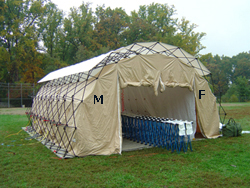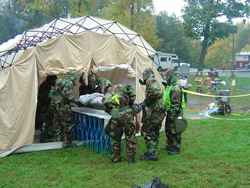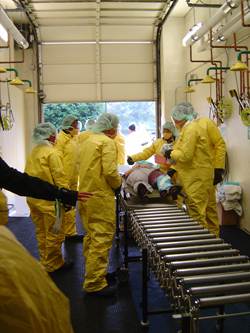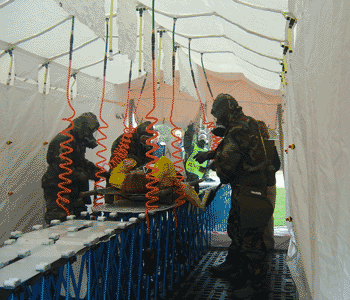Photos of Decontamination Facilities and Procedures

 |
Summary of decontamination procedures
|
||||||||
|
Key Info: 1. Decontamination should not delay or impede stabilization of any patient. 2. Removal of all clothing can reduce contamination on the patient up to 90%. |
- Survey patients/victims with radiation survey meter prior to decontamination to document location and level of contamination
- Where possible, note location of contamination on radiation survey chart (PDF - 49 KB)
- Non-ambulatory victim decontamination
- Medical triage officer is stationed close to tent entrance to be sure needed lifesaving procedures are begun before decontamination
- Decon staff rolls non-ambulatory contaminated litter patient along center ramp from entrance to exit while performing decontamination shower (see coiled, red hoses hanging from tent ceiling, Photo 2)
- Carefully remove clothing from patient/victim
- Property of each individual should be bagged individually in airtight container
- Label property bags with patient/victim's name, date, and time
- Storage of property must be secure, particularly if forensic inquiry is likely
- On the exit side of the decontamination line, provide warm, clean clothes (or sheets/blankets)
- See decon cycle description below
- Ambulatory victim decontamination
- Victims pass through sides of decon tent behind tent flaps
- Hanging shower lines inside side panels (not shown Photo 1 and Photo 2) facilitate showering with warm water, soap, shampoo
- After each decon cycle through tent
- Medical triage officer reassesses patients, especially litter patients, to be sure they are still stable
- Radiation safety personnel re-scans patient/victim with radiation survey meter and records information on radiation survey chart (PDF - 49 KB)
- Radiation counts in excess of 2-3 x background levels may indicate need for additional decon cycles
- Cease decontamination of skin and wounds when
- Radiation survey reveals less than twice background
- When there is no significant reduction between decontamination efforts, and before skin becomes abraded
- Practical decon considerations
- In mass casualty events, decon facilities should be set up away from primary medical facility and hospital to avoid cross contamination
- Throughput for decontamination in facilities shown above in Photos 1-3 is likely not to exceed 100 patients/hour
- Although not recommended in large mass casualty events, capturing effluent water from shower in bladders may be considered in smaller events.





